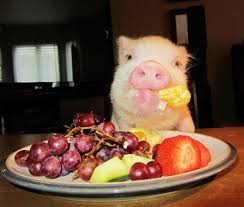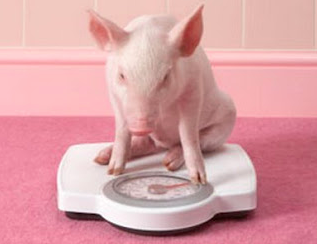
Overfeeding
By Nancy Shepherd and edited by Brittany Sawyer 2016
There are way too many overweight pigs out there. Again, this is not the pig’s fault, but due to the owner actively overfeeding the pig. It’s true that pigs relish food — in fact, pigs are food-possessed. A pig would not be a pig if she didn’t have such an obsession for chow. It is, however, the pig proprietor’s job to see that her pig receives a well-balanced, proper diet in the correct quantity. In the wilds the potbellied pig exists mainly on a high-fiber, vegetarian diet, collecting roots and various bug treats as she snurddles about. Under domestication our pigs ingest a high protein pig ration that most certainly provides more than enough nutrition when fed in very small amounts.
As a pig parent, you must determine the proper ration and amount to feed your pig by following recommended guidelines and paying attention to your pig’s condition . A grown pig generally can sustain herself quite nicely on two cups of pig food per day. Don’t allow your pig to trick you into feeding her more than her prescribed ration. You can make your pig think she is getting more than the usual amount of food by applying some of the following suggestions.
Feed her lots of small meals a day is ideal. Of course, this will depend upon your working schedule; but, if possible, split her daily food allotment into three equal portions and spread the feeding over the course of the day. A good routine would be to feed one-half of the pellets in the morning, a fresh vegetable salad for lunch and the other half of the pig chow at supper time. If two meals suits your schedule better, then feed half of pellets before work and the other half at your usual dining time. A before-bed snack seems to make piggies most content.
You may want to incorporate a treat dispenser into your pigs eating regimen. This is a ball that you can add feed pellets to…an empty milk job will do. As the pig pushes the ball around, the pellets fall out of pre-drilled holes for her to happily lap up. This encourages exercise while your pig eats.
Food sprinkled into a rooting box is another excellent dining option. You can fashion a rooting box out 2 x 4’s with a plywood bottom, or simply fill an oversized litterpan or small children’s wading pool with smooth, river rocks. By using any of these props, your pig satisfies her essential rooting needs while prolonging the eating experience.
If your pig whines around constantly hoping for food treats, don’t succumb. The credo is: No Free Food! What does this mean? It means that your pig is required to complete a task or in some way cooperate with you before a food reward is earned. This is especially indicated at the toddler stage (3 to 5 months of age) when a pig forms the behaviors that will remain with her for her entire life. Use food to train your pig to do either tricks, such as “circle” and “sit” – or obey commands, such as “come” and “stay.” Your pig will be highly motivated and eager to please knowing there is a reward attached to a behavior. You, on the other hand, will not be harassed with a whining, obnoxious house mate, but rather a cooperative, ready-to-please pal.
It is perfectly acceptable for you to feed your pig her complete portion at the designated meal times, but for treats and extras, abide by the no free food rule. For families who have the tendency to feed their pets too many extras, set aside the complete day’s ration of treats in a bowl, away from the pig. As the day progresses, family members may use this food to train their pig. When the tidbits are gone — that’s it. Be prudent and don’t let your pig train you to feed her at her every whim. After all, you are not a human vending machine, much to your pig’s dismay. You are, however, the one who makes the rules, you know – not the pig-a-rooter!
NAPPA offers the following feeding guidelines:
Piglets
Nursing to 6 weeks Free feed a starter ration 6 weeks to 3 months Gradually decrease from free-feeding until each piglet receives 1 to 1 1/2 C of grower per day.
Piglets and Breeding Stock
3 months to adult approximately 2 Cups of maintenance ration per day
Lactating Gilts and Sows raising females can be fed free choice, or follow this guideline:
2 C/day plus 1 C per suckling piglet.
Example: Sow with 5 piglets would receive 7 C/day.
Boars
Feed according to need, from 2 C to 8 C/day depending on level of activity/condition.
Note: This is a guideline only. Individual metabolisms vary and feed levels need to be adjusted accordingly. Check with your vet to determine the appropriate amount of feed for your pig specifically. Remember, once the weight is gained, it is extremely difficult for pigs to lose weight. They do NOT lose weight by exercise, they’re not physically able to do cardio workouts, so you must balance activity with diet and adjust accordingly s your pig matures.
